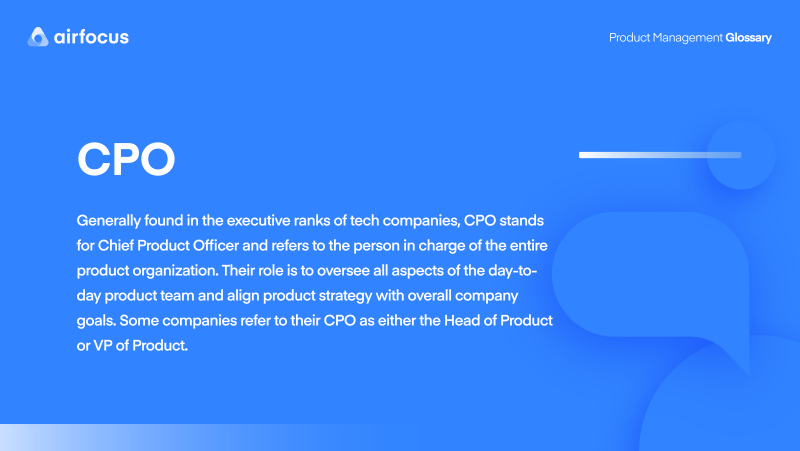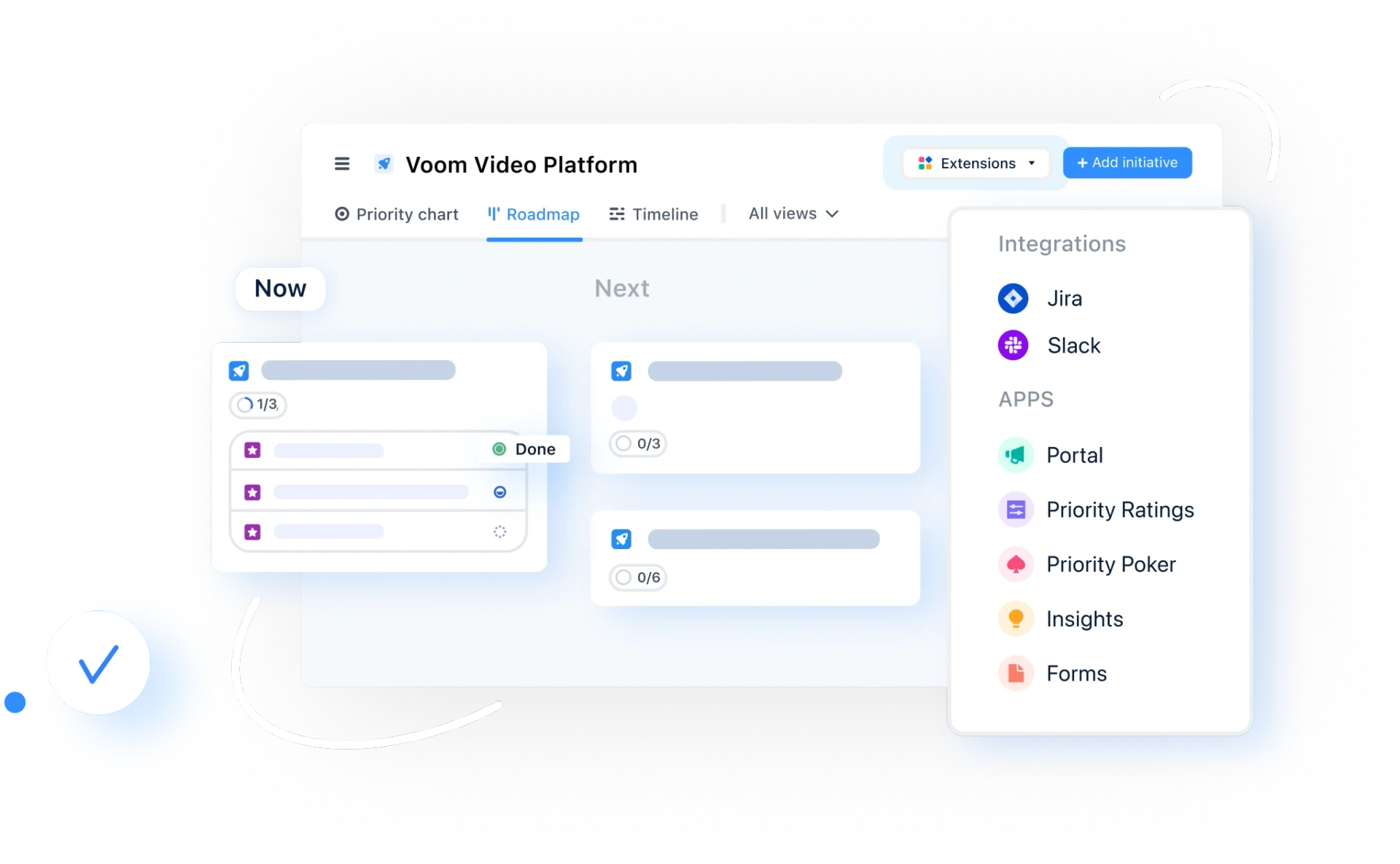Chief Product Officer in Business
What does CPO stand for?
CPO definition
Generally found in the executive ranks of tech companies, CPO stands for Chief Product Officer and refers to the person in charge of the entire product organization. Their role is to oversee all aspects of the day-to-day product team and align product strategy with overall company goals.
For more details, refer to the full CPO glossary term.
What is a CPO strategy in business?
A CPO strategy in business refers to the placement of a Chief Product Officer to lead up the product organization. CPOs oversees all product activities within the company. Their duties include supervising Product Owners and Product Managers, managing the development of products from conception to delivery, and evangelizing those products both internally and externally.
Who does the CPO report to?
A tech company’s CPO, or Chief Product Officer, usually sits within the executive team and reports directly to the Chief Executive Officer or CEO. Some companies refer to their CPO as either the Head of Product or VP of Product.
Key objectives for CPO
A CPO sits high up in the product management organizational chart, reporting to the CEO as mentioned above. This means the CPO must be simultaneously aware of the company’s needs, goals, and metrics for success, while maintaining an in-depth view of a product’s roadmap, opportunities for development, and user base.
The primary objectives of a CPO are:
Leading and facilitating the product department/organization
Supervising product managers
Mentoring the PM team
Creating a strategy and a vision for product management
Marketing products
User research
Connecting companies to their customers by evaluating consumer needs
Meeting with stakeholders and investors to present product proposals
Determining the price of the new products
Communicating with various teams within the organization to ensure the product’s development moves forward as planned
Product analytics, metrics, and marketing initiatives
Product vision and innovation
Some CPOs are also in charge of the manufacturing, procurement, and distribution of the product.
As CPOs find themselves having numerous responsibilities and objectives, they must meet certain criteria to be a good fit for the role:
Be capable of interpreting and understanding different types of data
Be strong supervisors and leaders
Deep understanding of publicity and marketing
Remain sensitive to users and customers, especially regarding feedback and complaints
Possess excellent vision and strategic product skills.
The average salary of a CPO
The average salary of a Chief Product Officer in the United States is $254,980 per year. The range usually is between $224,980 and $284,080, mostly depending on certifications, years of experience, additional skills, and education.
The average salary of CPO in other countries are:
In Germany: $115,420
In the United Kingdom: $117,998
In Japan: $136,255
In India: $51,783
In Australia: $179,984
In Poland: $88,888
In France: $145,384
In Brazil: $122,178
In Singapore: $208,122
What is a product management organizational chart?
An organizational chart is a diagram that helps team members visualize a company’s internal structure by showing details about the responsibilities, roles, and relationships between members within the business. Therefore, a product management organizational chart will display and map out the product management arm of an organization.
Product management can report to a wide range of parts of the company. It sometimes reports to engineering in very tech-heavy roles. Other times, it reports to marketing, especially in consumer-oriented businesses.
However, a CPO is a role that oversees all matters related to a company’s product, so the CPO sits at the top of the organizational chart.
Among the departments they manage, there are product management, user experience research, product analytics, and design.
Even the leaders of product management are supervised by the CPO, such as the Direct of Product Management, the Head of Product Analytics, the Director of UX, and the Direct of Product Marketing.
It falls under the CPO’s responsibilities to make sure that these key leadership roles are performed in alignment with the company’s strategy and vision in an efficient way.
The CPO represents a crucial mentor for all the other product management personnel.
They serve an important role in influencing the strategic direction and culture of the product organization.
Read our range of product management case studies from airfocus users.
Real-world CPOs
Here are just a few CPOs making waves at major companies.
Tomer Cohen - CPO at LinkedIn
As CPO at LinkedIn, Tomer Cohen has been leading all teams responsible for building and creating the platform’s products and experiences. Cohen has set out product strategy and oversees product development, user experience, business development, content creation, and customer operations.
Tamar Yehoshua - CPO at Slack
Tamar Yehoshua has led Slack’s product, design, and research teams through 10x revenue growth, the company going public, and its acquisition by Salesforce. Yehoshua’s expertise is leading and delivering innovative products at scale.
Smita Hashim - CPO at Zoom
Smita Hashim joins Zoom with a strong background in product creation, including Microsoft IPTV and Google Cloud. Most recently, Hashim has been working on Zoom’s AI companion, which has been built to improve efficiency and team effectiveness.
David Schmaier - President and CPO at Salesforce
With more than 30 years of experience with enterprise software, David Schmaier has found a great fit with Salesforce. Schmaier is responsible for overseeing the platform’s global product team, strategy, and vision.
Prakash Ramamurthy - CPO at Freshworks
Prakash Ramamurthy has been leading strategy and vision for a suite of customer and employee engagement products at Freshworks. Ramamurthy has an extensive track record of building high-quality cloud-based services and leading high-performing teams.
Tips for a successful career as a CPO
If you want to build towards a career as a Chief Product Officer, here are a few top tips.
Hone your communication skills
The role of Chief Product Officer will require you to work with multiple teams at one time. This requires strong communication skills so you can make it clear what you expect from each team.
Brush up on your decision-making techniques
As CPO, you have the last word on many key decisions. You need to be confident in your decision-making skills. Be sure to take in as much information as possible when considering your options.
Learn how to lead people
Product teams will look to you for guidance during development. It’s up to you to lead them toward the final result you’re looking for using coaching and your experience.
Focus on improving the customer experience
Customer-centricity is now a key part of most product strategies. That means the customer should always be central to any decision you make. Customer satisfaction is crucial to your company’s growth.
Get familiar with all aspects of the business — not just the product side of things
You should be building products that reflect the company's mission and values. Making cool things for the sake of making them won’t always help your company grow so keep those goals in mind.

General FAQ

Glossary categories
Experience the new way of doing product management

Experience the new way of doing product management








